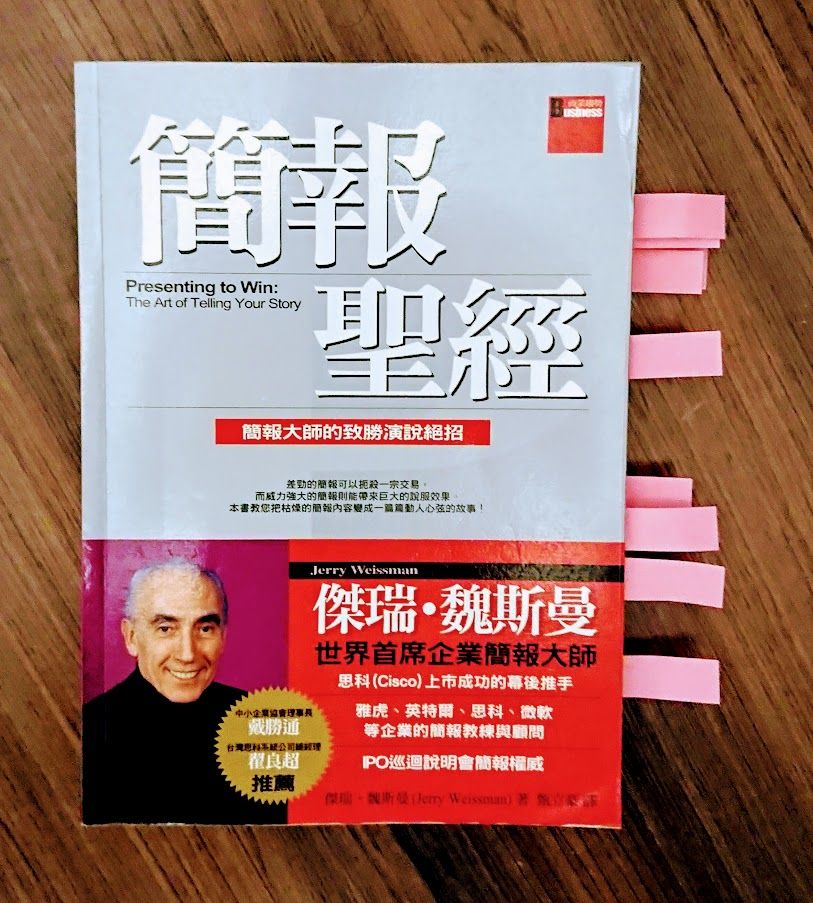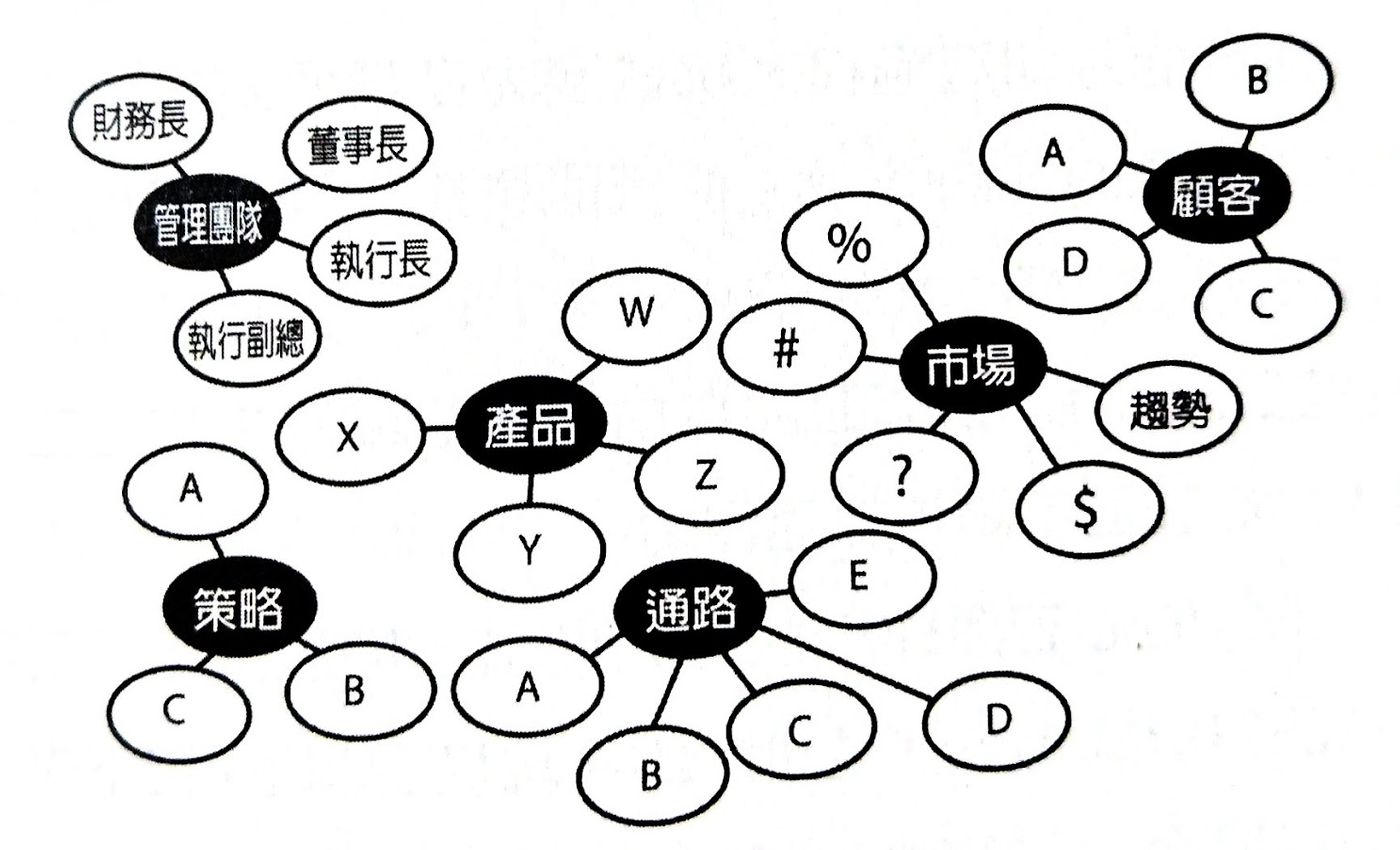
半導體外商的小小螺絲釘,遊走於廢青與社畜之間。熱愛閱讀,喜歡透過書本探索外在、內化自我。希望藉由書寫打開與世界交流的一扇窗。 個人部落格:https://maxjamesread.com/
Briefing Bible: Recommended by old books, story persuasion of IPO briefing masters!

Briefing is an essential skill for many jobs. But such "hard needs" seem to be completely ignored by our school education. I believe that many people have entered the company to learn how to do presentations. Do you feel that although you have learned a lot of presentation skills, you still cannot express it fluently, and you are always stung by your boss or customers?
Maybe you don't need those skills, but a "storytelling" system!
Today's introduction to the "Bible of Briefing", author Jerry. Weisman was originally engaged in the performing arts industry, but by accident, he began to use the "storytelling" skills he developed in the TV circle to help more than 400 companies do pre-departure training for IPO tour briefings, and was the driving force behind the success of these companies' listings. This book will teach his unique "power presentation method", so that you can create a persuasive presentation that tells the story you want to tell just by doing it.
This book is actually a bit old, the first edition was in 2004, and the first time I read it was in 2014. I recently reviewed this book when I was consolidating my briefing knowledge, so I wrote down my experience. Interestingly, in retrospect I found that many of these ideas and writing were interoperable. Below I will divide it into three parts, from briefing preparation, production to report to introduce this book, and give some examples of the application of my writing.
【Preparation of Power Briefing】
First of all, don't open up a presentation software like Power Point right away and start digging in. Some prerequisites must be completed before your persuasion path will go smoothly.
(start with the end)
All briefings hope to move the audience from the starting point (the starting state) to the ending point (your intended purpose). So before starting a briefing, ask yourself: What is the end of this briefing? What do you want to achieve with this report?
The goal can be getting the boss's approval, or getting the customer to pay for your product. In short, you need to find the bullseye first, and then use the arrow to poke it. The so-called beginning with the end in mind, is to have a purpose, and then plan the journey. Never type blindly to animate, only to realize in the end that the point you want to convey is not displayed in the presentation.
This is the same in writing articles. Before I start writing, I also think about what the purpose of my writing is and what message I want to convey to readers, so that I will not lose my way in the text maze.
(audience first)
Since the role of the briefing is to drive the audience towards your desired goal, it can’t just be self-centered. The author says that you have to put your audience as much as your goals and find a balance between what your audience wants to hear and what you want to say.
So think about what your audience needs before you give a presentation. How does this report benefit them? From the audience's perspective, don't just focus on your own briefing. Use the following questions to help you think:
- This is important to listeners because...?
- What does this mean for the audience?
- Why am I telling the audience this?
You can also use these questions over and over again in your presentations to make sure you haven't strayed from your audience's needs. The author believes that the ideal briefing is one where the audience can easily follow your content and be led by your nose. Just keep them feeling "aha" and you'll be successful.

【Production of Power Briefing】
Once you've figured out your purpose and your audience's needs, move on to the briefing section. Let's start by thinking about the content.
[Briefing Thoughts]
The author believes that the " intuitive first, then logical " approach should be followed when thinking about content. What does that mean? To put it simply, it is to first let the brain associate arbitrarily, stir up various intuitive ideas, and then organize them. There is no limit to brainstorming, the only thing to pay attention to is that you still have to deduct your own goals and audience needs when making associations.
How do you organize after a cluttered mess of ideas? The author suggests that all ideas can be summarized into several big concepts, and then other ideas can be pulled under his command (as shown in the figure below).

The author emphasizes that please follow the "first throw and then repair", throw out various ideas and then summarize and delete. Many people will want to skip this step, thinking: "I'll just list the key points first, won't it save time?" But this approach is often too hasty to achieve. This is similar to writing. When I draft an article, I will try to dig out all kinds of ideas from my mind and organize them.
[Selected structure]
After deciding what the briefing needs to include, the next step is to use a logical structure that guides the audience downwind to the finish line. The authors call this technique "structural flow". The book summarizes 16 briefing structure flows. Here are 3 of them, and use my article as an example.
- Modular <br class="smart">Modulation is the grouping of similar content elements together. There is no order of different modules, you can change the order at will, which is a relatively loose briefing mode. For example, I arranged the content in this way in "Taiwan Taste in the Alley" .
- Space <br class="smart">When the content is divided into layers, the space method can be used, and the layers are advanced from bottom to top or from outside to inside. An article like "How to Read a Book" is to read from the lowest level of basic reading, all the way up to the most advanced topic reading.
- Problems and Solutions <br class="smart">Using a problem to attract the audience's attention, followed by a solution is a common presentation technique. It can be said that the built-in "What's good for you" function makes the audience feel "Aha, this is really useful!". This is what I use in this article.
[Set the opening]
Now that you have the structure, it's time to build the beginning. Getting started is important, because that's what determines whether your audience will focus on your briefing next, or doze off, scroll through their phones, and focus on the ups and downs of the stock market. I will give three examples of opening remarks that everyone can use at work:
- Questions <br class="smart">Ask the audience questions is a very common start. As long as there is a question, you can easily grab their attention.
- Statements of fact <br class="smart">Present little-known statistics. The more amazing and unusual the effect, the better.
- Retrospective / Foresight <br class="smart">Use the now-and-then approach to create contrast. Use the contrast to grab the audience's attention.
It is important to note that no matter what kind of opening line, it must be able to connect to your "end". Don't use cool openings for grandstanding. If you want to learn these openings, I think you can watch more TED and see how the speakers create their openings. In addition, these methods are actually very common in articles. You can also see how those writers you like use these methods.
The above is all the structure of the entire "Power Briefing". The book uses a diagram to organize it as follows:

[Adjust vision]
"Visual" is the biggest difference between presentation and writing. A good presentation must not just copy and paste the speech, but use diagrams and graphics to help the audience understand your content. Of course, the visual arrangement is not easy. You may find that many briefings are crammed into a push chart, and various animations are floating, but it is even less clear what they are trying to express.
The author believes that to make a successful visual effect, we must start with two habits of our gaze at the briefing:
- Swipe left to right <br class="smart">First, when viewing a presentation, people's eyes tend to start at the top left and then move to the right.
- Line wrap <br class="smart">When the content is more than one line, the eyeball needs to turn back to the left and continue to read to the right.
Therefore, when we arrange the content, we should try our best to conform to the habit of eyeball reading, and arrange the elements of the presentation from left to right. At the same time, try to minimize the number of times the audience glances down, because too many line breaks can cause eye fatigue.
Let's look at some practical examples. In terms of textual content, "emphasis points" can be used instead of "complete sentences". Because sentences can easily exceed one line, they must be read on a new line. And if you want to use animation, you should also follow the movement from left to right to display.
The same is true for charts, whether you use a line, pie, or bar chart, make it so that the audience can understand what it means by swiping from left to right. Don't let their eyes roll up and down several times, and they still don't understand what plaster this chart is selling. Remember a simple concept "less is more", the more precise and clear the content, the more able to catch the audience's attention.

【Report of Power Briefing】
Finally, let's talk about the part of the play report. Basically, the trick is to practice and practice. However, there are a few tricks to liven up your report.
For example, we can use the internal chat to make the presentation of the presentation smoother. It's like asking some rhetorical questions at the turning point, such as "then what do we do next?" or "how do we meet market competition?" to help the audience connect with the content after that.
In addition, the briefing can also be paused at an appropriate time, and the sentence pattern "Let's review what we just mentioned..." can be used to help the audience summarize the content. The book summarizes 12 kinds of internal chatter, everyone who is interested can study it by themselves.
In addition to the series, I think there is a very useful technique in the book, let's call it " incorporating the audience into the syntax ". The following sentences can be said in the briefing:
- let us……
- Remember what we discussed earlier...
- you have seen...
In short, it is to bring more listeners into the content, increase the introduction, generate a sense of participation, and let them continue to listen attentively. By the way, I think this technique works well in writing as well, giving the reader the feeling that you are talking to them.

【Summarize】
in conclusion. Before giving a briefing, please confirm the purpose of your report and think about how it will benefit the audience; when making a briefing, first brainstorm various contents that may be needed, then organize and delete selections, and use the structural flow to sort out the order of the briefing . Visually, remember to arrange the content flow from left to right, and adhere to the principle of less is more; finally, you can use interspersed speech to make the report smoother, and at the same time include the audience to increase the sense of intimacy.
The Chinese title of this book is translated as "Briefing Bible", although it is a little exaggerated, but it does have a copy. Many concepts still seem to be outdated. Too bad this book seems to be out of print. If you want to read, you may want to find second-hand resources or try your luck at the library.
Although there are various learning resources related to the briefing, I think they are all the same. It is recommended that you buy one or two books and study them. If you are interested in taking classes, I highly recommend the courses offered by the Briefing Bakery in good schools, whether it is the mental method or the actual combat chapter, it is quite worth taking.
- Precise Design: Briefing on the Mind and Dharma
- Designing with precision: PowerPoint skills in action
As a final digression, when I was looking through the book, I saw that the author used Netflix's IPO brief as an example. When I first read it, I didn't feel it at all. I really didn't know Mount Tai. If I had directly All-in back then, the stock price would have risen tenfold now...
In short, you still have to work obediently without making any money. I hope this article will help you better understand how to use the briefing to tell the story you want to tell. I wish you all the best in the briefing and a smooth salary increase!
If you like this article, please help me clap your hands on Appreciating Citizens ! If you have any ideas, please leave a message and tell me!
Like my work?
Don't forget to support or like, so I know you are with me..
Comment…